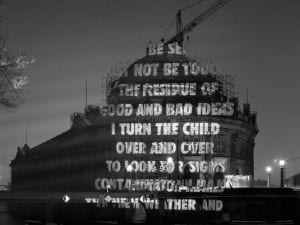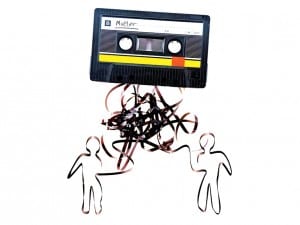For more than a decade, sound has been the centre of Nicolas Bernier’s practice, whilst also being an alibi for investigations into the plurality of its possible interrelationships with photography, moving images, design, dance, theatre, visual art and technology. His 2014-2015 work, Frequencies (light quanta) was longlisted for the Aesthetica Art Prize in 2016. We talk to the artist about influences, inspiration, and maneuvering through his medium.
A: Your longlisted work frequencies (light quanta), uses the smallest measurable value of energy. What drew you to the quantum as a medium of art?
NB: The reason comes from the very core of what it is, I think, to be an artist (or just a human being, frankly) : curiosity, interest and a desire to discuss with the world that surrounds us. I’d love to tell you how expert I am in the field of physics and that I grew up surrounded by science and so forth, but it is rather the opposite. Science is not my field, or, to paraphrase Marcel Duchamp: “I am not the scientific type.” So this is precisely why I’ve been drawn into quantum physics, because it is far from my natural interests. Yet such a fascinating universe. In order to create challenging art, an artist should challenge himself first, trying to find new grounds for his ideas, new paths where he never thought he could go. That’s how I like to work and this is how frequencies (light quanta) started.
That said, I’ve always been into “smallness”, into creating many small gestures as opposed to larger gestures, so this is one of the points where we can find a continuity the work I’ve been developing over the last 10 or 15 years. This world of particles also have strong connections with the world of audio since sound particles (like granular synthesis) have been one of the most important sound transformation techniques in the last decades.
A: By making poetic reading of machines and electronic circuits, do you hope to invoke an interest and appreciation of quantum science?
NB: I think people will see or feel in response to their own specific backgrounds. I simply hope they would make a poetic reading of my poetic reading, adding a modest contribution to the cycle of life. I see frequencies (light quanta) a bit like if I was myself a particle and I was travelling in a supercollider but other people will probably see it other ways and that’s the beauty.
A: Where did your fascination with sound begin?
NB: There’s been a couple of different steps showing different kinds of interest within the field of sound. One of these steps is circa 1998, when I start to get interested in radio documentaries. From there I get interested into the power of field recordings to evoke images, to help to tell a story. A story without images is adding something instead of removing something : it adds the own images the listener might find in his mind. That’s the magic of sound.
At the time, I wasn’t interested in abstract sounds…. so I went there! Like I was saying in the first question, this is the way I push things, trying to grasp things that I don’t understand, that’s we learn the most. So from documentary-ish field recording, I went to abstract juxtaposition and montage of field recordings, then to totally abstract sound composition, cutting and combining them according to their spectromorphological contrasts. “When you cut into the present the future leaks out” said William S. Burroughs. So did I. Sounds, whether they are abstract or not, are so narratives… they are for me the most poetic storytellers.
A: What is the process like from concept to an exhibition of your unique artistic practice?
NB: I am against deadlines in the arts. So I like to give some space in a creative process, to let it grow is own way, at his own speed. Even though we always start a process with some hypothesis, we can never know where the process will bring us and that’s the beauty. Sometimes the idea is so clear that it is just a matter of «making/building» the thing, but most of the time there are all sorts of ideas and it is a matter of taking the time to see how to make the right connections between those ideas.
As I come mostly from a musical background, I will often start with composing some sounds because that’s the most natural for me. Then those sounds will help me to have visual ideas. The sounds will already give the colour, the narrative, the direction to the story I will be telling. After a phase of technical and conceptual trials and (mostly) errors, I finally find the visual apparatus I need to create. I go into production with my fabrication team. Then, there is the last long phase where we need to adjust every details (which sometimes means to recreate all the sound, or all the music, or all the electronics…. or everything!).
A: You’ve utilised photography, moving images, design, dance, theatre, visual art and technology. Are there any other spheres of the art world you hope to move into?
NB: Is that not enough?!! (laughs) I don’t force myself into being multidisciplinary. I just try to give life to some ideas, whatever they are, in whatever form they asked to be created. So I can’t tell where I will go next. For now, I am more and more interested into architecture and design. I don’t think I am done with light either so I might continue in that vein for a while. In the meantime, I miss the simplicity of performing music so I might go back to improvise sound. I also love paper. I’d love to make books, that’s one of my fantasy. So, I’ll just follow those fantasies as far as I can possibly can.
Entries are open for the Aesthetica Art Prize 2016 until 31 August.
For more information and to enter: www.aestheticamagazine.com/art-prize
Credits:
1. Frequencies (light quanta), 2014-2015. Courtesy of the artist.





